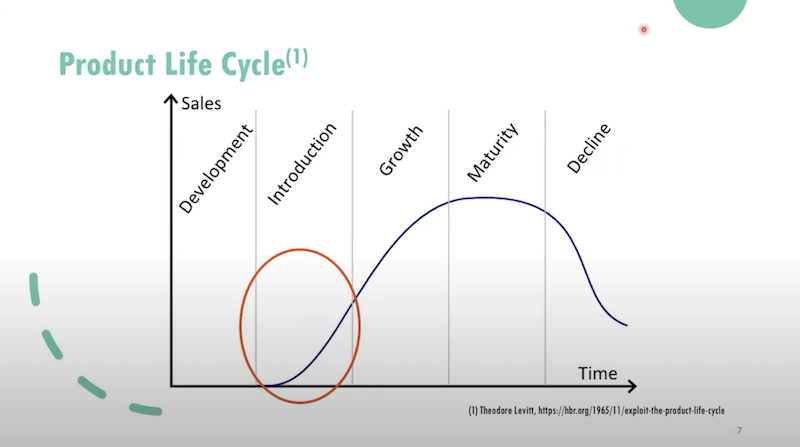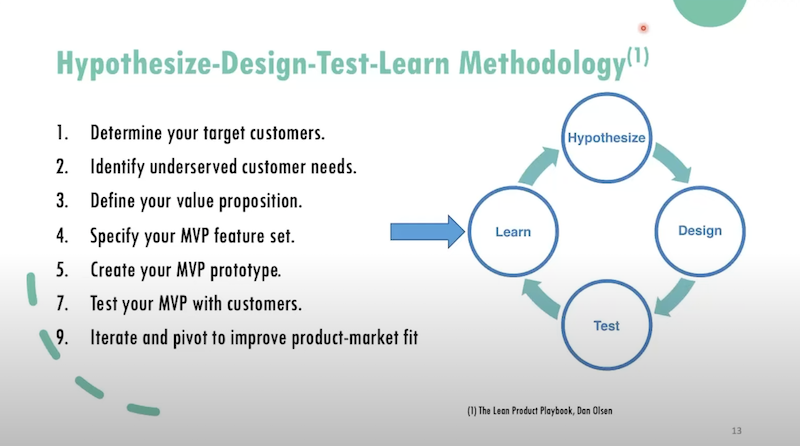Updated: January 24, 2024 - 11 min read
The Minimal Viable Product (MVP) is a pivotal tool in a Product Manager's toolkit. In this guide, we’ll cover exactly what an MVP is, why it’s important, when to use them, and, importantly, how to build an MVP. And of course, we’ll explore real-world examples of MVPs used across a diverse range of industries, as well as equipping you with some fantastic free resources for Product Managers.
Editorial note: This post is based on a talk on how to build an MVP by Khaled Alosaimi, Sr PM at Amazon, and contains additional insights and examples from the Product School team. You can watch the webinar in full below.
Let’s start with a quick recap:
What is an MVP?
Eric Ries, pioneer of the Lean Startup movement, describes a minimum viable product (MVP) as the:
“version of a new product which allows a team to collect the maximum amount of validated learning about customers with the least effort”
We can also think of MVPs like this:
Minimum: build as few features as possible to solve a customer pain point and attract real users.
Viable: your product should deliver at least part of your value-proposition*, so users have a reason to use your product and give you feedback.
Psst! If you don’t have a clear value proposition, check out this Free Value Proposition Canvas you can use to build products that matter.
In short, MVPs aren’t about creating a stripped-down version of your product, but rather about validating a product idea.
What are the benefits of building an MVP?
Okay, so now it’s clear what MVPs are, but what are the benefits of building them?
1. Confirm the right target audience
Launching an MVP allows businesses to identify and engage with their target audience early on. By interacting with initial users, companies gain insights into their demographics, behaviors, and preferences, ensuring more precise and cost-effective marketing strategies.
Top tip: Get help defining your target audience with our free user persona template!
2. Problem-solution fit
Before investing in full-scale development, an MVP ensures that the product or service effectively addresses users' pain points. This fit is crucial for long-term adoption and user loyalty.
3. Early monetization
Instead of waiting for a fully fleshed-out product, companies can start generating income early in the product lifecycle – crucial for startups requiring cash flow.
MVPs also allow you to experiment with different monetization strategies—whether it's subscription models, one-time payments, or freemium models—to find what resonates best with users.
4. Minimizing risk and maximizing ROI
By focusing on core features, companies avoid the high costs associated with developing non-essential functionalities that users might not need or want. In this way MVPs ensure resources are used efficiently, paving the way for a maximum return on investment. If the concept doesn't resonate, businesses can pivot without having invested excessively in a particular direction.
What’s more, demonstrating that a product has real-world demand and can generate revenue makes it more appealing to investors. It's tangible proof of concept and market viability.
When should you build an MVP?

As we’ve just seen, one of the goals of creating an MVP is to collect the maximum amount of validated learning about customers with the least effort, in order to quickly establish if there’s a product-market fit before you invest more of your resources into the product. This makes MVPs particularly pivotal in the early stages of the product life cycle.
More specifically, there are two main times when you should build an MVP:
When you're trying to validate learning - Are you targeting the right users? Is your solution addressing the correct problem?
When you're entering a market with a new concept - Will this solution work in this market? Is this a product that people are willing to pay for?
How to build an MVP
So far, so good. You know why we need MVPs and when they’re most useful. But how do you actually build an MVP?
First up you’ll need to do some homework. Before you start building an MVP, ask yourself the following questions:
Exactly what problem are you trying to solve? (Value proposition)
For whom do we solve that problem? (Target market)
How big is the opportunity? (Market size)
How will you measure success? (Metrics/revenue strategy)
What alternatives are out there? (Competitive landscape)
Why are we best suited to pursue this? (Our differentiator)
Why is now the best time to introduce this product? (Market window)
How will you bring this product to market? (Go-to-market strategy)
What factors are critical to success? (Solution requirements)
Given the above, what’s the recommendation? (Build an MVP or not?)
While you probably can’t wait to start building your MVP, taking the time to lay its foundation is crucial. Building an MVP is an investment of time, resources, and effort, so make sure it's worthwhile.
Hypothesize-Design-Test-Learn Methodology
Once you’ve established it makes sense to create an MVP, how can you actually build one? Let’s take a look at a method found in The Lean Product Playbook by Dan Olsen.

Hypothesize
Define your target customers
Clarity on whom you're serving is paramount. Recollect the insights and data gathered during your preliminary market research and pre-MVP brainstorming. Understand your target users' demographics, preferences, and pain points. Remember, your MVP should resonate with this specific audience.
2. Identify underserved needs
Recognizing gaps in the market can set your MVP apart. What are the needs or desires that current solutions don't address adequately? Recognizing these underserved needs not only sets the direction for your MVP but also strengthens its value proposition, ensuring your product fills a void in the market.
3. Develop your hypothesis
Beyond just identifying the core problem, delve deeper. Segment the issue into detailed sub-hypotheses. For instance, if you're trying to improve online shopping experiences, one sub-hypothesis might be that "users find current checkout processes cumbersome." Multiple sub-hypotheses allow you to explore various facets of the problem, potentially leading to a more holistic solution.
Design
4. Specify your MVP feature set
Now that you’re clear on your target audience and value proposition, you can get to work deciding which features your MVP will include. Remember, you want to validate your hypotheses quickly with as little effort as possible, so stick to only the features you need to validate your idea.
5. Design the prototype
Crafting a prototype doesn't always require intricate detail or high fidelity. It's essentially about embodying your solution in a form that's testable. Whether it's a paper sketch, a wireframe, or a basic interactive model, the objective is to have a tangible representation of your idea that can be subjected to user testing.
Test
6. Test your MVP with customers
Once your prototype is ready, it's time for real-world exposure. Engage with your target customers and observe their interactions with your MVP. Collect both quantitative data (like completion rates) and qualitative insights (suggestions, pain points).
Learn
7. Iterate and pivot
Post-testing, take a step back and analyze. What worked? What didn't? Which sub-hypotheses were validated, and which were debunked? Depending on the feedback, you might need to tweak features, redesign certain elements, or sometimes pivot your entire approach. This iterative process ensures that you inch closer to the optimal product-market fit with every revision.
For more tips on how to build an MVP, check out the Product Manager Certification.
Real-world examples of MVPs
There are many different types of MVPs. Let’s have a look at some of them and how they were used by major companies.
Fake-door MVP
A fake-door MVP is a method used to test interest in a product or feature before it's actually built or fully developed. The concept is akin to presenting a "door" to users, and if they try to "open" it (i.e., click on a link, sign up for a new feature, etc.), they see a message indicating that the feature or product isn't available yet.
The main goal is to measure the number of clicks or interactions with the "fake door" to gauge user interest in the proposed feature or product.
The benefits of a "fake door" MVP include:
Validation: It helps in gauging genuine user interest before investing significant resources into development.
Cost-Efficiency: It's a low-cost way to test demand without fully developing a feature or product.
Flexibility: Based on user interactions, companies can decide to pivot, proceed, or prioritize features*.
*Prioritizing features can be tricky – make your job easier with our Free Feature Prioritization Template
Before building its comprehensive file-sharing and storage solution, Dropbox built a fake-door MVP in the form of a simple video explaining how it would work. Without committing a single line of code, Dropbox was able to gauge consumer interest. The overwhelmingly positive response validated the demand, and they proceeded with full-scale development.
Concierge MVP
A concierge MVP is a methodology used to test a new product or service concept by manually carrying out the service or delivering the product's value proposition, even if that manual effort isn’t scalable or the final intended mode of operation. Instead of building a fully functional product with all the features and automated processes, the team essentially acts as a "concierge," hand-holding the user through the experience and simulating how the eventual product would function.
The benefits of a "concierge MVP" include:
Deep User Understanding: By being directly involved in the delivery of the service or product, the team gains invaluable insights into user needs, preferences, and challenges
Cost-Efficiency: This approach avoids the heavy costs associated with building a fully automated solution before validating the core concept.
Flexibility: The direct involvement with users allows for immediate pivots and tweaks based on real-time feedback.
A classic example of a concierge MVP is Airbnb. In their early days, the founders of Airbnb took photos of the listed properties themselves and communicated directly with hosts and guests to facilitate the entire booking process, simulating the experience they envisioned for the platform. This manual process gave them insights into user needs and helped shape the development of the platform.
Single-feature app MVP
A single-feature app MVP focuses on building and releasing an app that offers just one primary feature or function to its users. The idea behind this approach is to concentrate on a single, core value proposition and ensure that it’s delivered exceptionally well, rather than spreading efforts thinly over a multitude of features.
This method can be particularly effective for startups or product developers who want to validate a particular concept or solve a specific problem without being distracted or overwhelmed by the complexities of a product with several features.
Advantages of a single-feature app MVP include:
Rapid Development: Focusing on one feature usually allows for quicker design, development, and release times.
Clear Value Proposition: With only one feature, the app's value is easy to communicate and understand.
Focused Testing: It's easier to gather user feedback and iterate when there's only one primary function being evaluated.
Reduced Costs: With fewer features to develop, costs are often reduced.
Quick Market Entry: You can get your solution in front of users faster, allowing you to start gathering data and feedback sooner
A notable example of a single-feature app MVP is Uber. In its early stages, Uber's primary feature was simply to connect riders with luxury vehicle drivers. All the complexities, like carpooling, food delivery, and various ride options, came much later. The initial app concentrated solely on validating the basic concept: Can we connect riders and drivers efficiently through an app?
Piecemeal MVP
A piecemeal MVP is an approach where a new product or service is developed using a combination of existing tools, platforms, or components, rather than building everything from scratch. The goal is to test a business hypothesis or validate demand without investing heavily in custom development. Essentially, it's about "stitching together" existing solutions to form a coherent offering for initial market validation.
Benefits of a piecemeal MVP:
Speed: Using existing components allows for rapid assembly and faster time to market.
Cost-effective: It avoids heavy initial development costs by utilizing already available solutions.
Focus on Validation: By not getting bogged down in the intricacies of development, businesses can focus on the core value proposition and test their hypothesis more directly.
Flexibility: As it’s built using modular components, it's easier to pivot, adjust, or replace individual elements based on feedback.
A classic example of a piecemeal MVP is Groupon. In its early days, Groupon didn't have a sophisticated platform or automated process. Instead, they used a simple WordPress blog and manually issued PDF vouchers to customers via email. Only after validating that there was genuine demand for the group-buying concept did they invest in building a more robust, custom platform.
An MVP isn’t just a product development stage—it's a mindset. It's about embracing continuous learning, testing, and evolution to ensure your product resonates with your target audience and delivers genuine value. So, as you embark on your MVP journey, remember to always prioritize maximum learning, product-market fit, and market validation.
Happy building!
Updated: January 24, 2024
